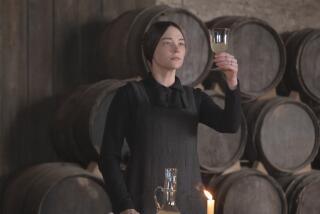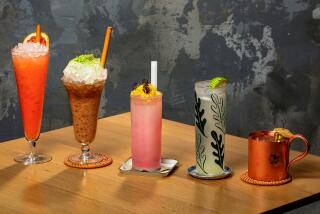Champagne: Will It Be Pop or Fizz? : Number in Party Governs Type of Bubbly to Purchase
There are two ways to drink Champagne on New Year’s Eve: quietly and intimately with someone you love, or in the carefree effervescent spirit of a New Year’s Eve bash.
When the party is only for two, there is time to savor the character of the Champagne, and you should buy the best. For larger groups, however, the pop is more important than the fizz, and quantity is often more important than quality, so serve a less expensive Champagne.
Although there are good Champagnes from Spain, some very good American Champagnes and a handful of quite good sparkling wines from other areas, the greatest sparkling wines of the world are those from France’s Champagne region.
If you are planning a quiet New Year’s Eve with someone special, the wine of the evening should be a fine French Champagne. It should be a wine of distinction, with enough body and character, enough subtlety and complexity, for it to become a third guest in the evening’s celebration.
Middle-of-the-Road Flavor
Each Champagne producer makes a wine that is the top of its line. These are called tete de cuvees. These are very special wines. Although somewhat overrated, the most popular of the tete de cuvees is Moet and Chandon’s Dom Perignon, with its very correct middle-of-the-road flavor.
Two slightly lighter-bodied tete de cuvees are the popular Louis Roederer Cristal and Taittenger Comtes de Champagne. Although very difficult to find, Bollinger’s R.D., which is a bigger, older wine with great balance and complexity, is a tete de cuvee that could make a Champagne lover’s evening.
All of these Champagnes are upward of $65 a bottle and all are great Champagnes, as are the tete de cuvees from other producers.
As an alternative to a tete de cuvee, consider one of the fine rose Champagnes. These are peach to pink in color, not as dry and austere as the tete de cuvees, and have a little more fruit in their bouquet than traditional white Champagnes. Among the best are those by Bollinger, Krug, Taittenger, Roederer, and Moet--the Moet rose, not the Dom Perignon rose, being the best value.
But these are not the right wines to serve at a large party, when the excitement and frivolity of the evening are center stage, not the wine.
Picking Champagne
When it comes to choosing a Champagne for a large party, price is and should be your main consideration. Once you have decided how many bottles you need (one bottle for every four people is a good rule of thumb) and how much you want to spend, choose the best deal you can find on a Champagne in your price range.
In many cities there is a big discount liquor shop, and while there isn’t much personal attention to be had in those warehouse-style stores, they often offer a discount of a dollar or two on a bottle. That can add up to quite a savings for a large party, so start by pricing Champagne there.
And keep in mind that if you are considering a premium French Champagne, all of the major Champagne houses produce fine wines. If one is being featured at a reduced price, buy it, even though it may not be one with which you are familiar.
All premium French Champagnes are not the same, even if they are all of exceptional quality. Each house, or maker of French Champagne, produces a wine with a particular style or flavor.
Among the more popular, those that are made in a big, full style are Bollinger, Roederer and Veuve Clicquot. In the medium-bodied range are Champagnes like Moet and Chandon, Mumm, Laurant Perrier, Piper Heidsieck and Maison Deutz.
On the lighter end of the spectrum are Perrier-Jouet and Taittenger. Buy a non-vintage brut in this category.
On the American premium Champagne front, Domaine Chandon, a Moet affiliate, dominates the market with its fine Champagnes, and it is generally my first choice. There are two other Franco-American California producers that would be good choices: Domaine Mumm and Piper Sonoma, though I prefer two of the strictly American-owned and -operated vineyards, Schramsberg and Shadow Creek.
In the modestly priced Champagne category there are half a dozen good choices. Korbell is probably the most popular, but Freixenet, Codorniu, Henkell and Bouvet Brut, all from different countries, are equally good Champagnes. Lembey, though less well-known than the others, is the best value for a modestly priced party Champagne.
The economical, bulk process Champagnes made by Andre, Jacques Bonet and Winemasters are the best in this least expensive category.
A note on opening Champagne: Although strictest etiquette tells us to ease out the cork so that we hear only a whisper, on New Year’s Eve you may want, as I do, to point the cork away from everyone, and anything else that might break, and just let it pop wildly at the stroke of midnight.
More to Read
Eat your way across L.A.
Get our weekly Tasting Notes newsletter for reviews, news and more.
You may occasionally receive promotional content from the Los Angeles Times.








